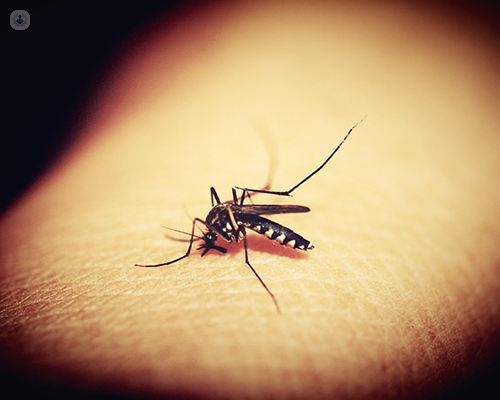Tropical diseases
Dr Basheer Peer-Mohamed - Paediatrics
Created on: 12-13-2013
Updated on: 04-20-2023
Edited by: Sophie Kennedy
What are tropical diseases?
Tropical diseases encompass all diseases that occur in the tropics and the term refers to infectious diseases that thrive in hot and humid conditions. The main reasons that infectious diseases spread in such regions are due to both environmental and biological factors that support high levels of biodiversity of pathogens and vectors, and hosts.
Social factors also play a role as to why the infections spread because efforts to control these diseases are undermined. Tropical diseases include malaria, leishmaniasis, schistosomiasis, onchocerciasis and African trypanosomiasis.

What are the most common typed of tropical diseases and infections?
The following are the most common types of tropical diseases:
- Tuberculosis – this infection represents the leading cause of death associated with infectious diseases globally, especially in developing countries. It is a chronic bacterial disease caused by Mycobacterium tuberculosis. The disease develops slowly and the illness is prolonged. Symptoms of TB include coughing for three weeks or more, coughing up blood and chest pain.
- Malaria – this is an infectious, hematologic disease caused by a Plasmodium parasite. It is a life-threatening mosquito-borne disease transmitted to humans through the bite of the Anopheles mosquito. Symptoms include shaking chills, high fever, sweating, headache, nausea and vomiting.
- Diarrhoea – rotavirus is one of the most common diseases that can affect young children. Rotavirus is found in countries such as Bangladesh, Somalia, Rwanda and Nepal. More serious epidemics can cause dysentery due to the bacteria Shigella dysenteriae. Symptoms include watery diarrhoea, fever, vomiting and abdominal pain.
- Leishmaniasis – this disease is caused by parasites of the Leishmania type and is spread through the bite of certain types of sandflies. It can be present in three main forms. The first, visceral leishmaniasis is the most deadly if left untreated in over ninety-five per cent of cases. Most cases occur in Brazil, East Africa and South-East Asia. Symptoms include fever, weight loss, anaemia and enlargement of the spleen and liver. The most common type is cutaneous leishmaniasis, which causes skin lesions, mainly ulcers on exposed parts of the body. These can leave lifelong scars and serious disabilities. The third strain of leishmaniasis is Mucocutaneous leishmaniasis, which leads to partial or total destruction of mucous membranes of the nose, mouth and throat. This is usually contracted in Bolivia, Brazil, Ethiopia and Peru.
How are tropical diseases diagnosed?
The doctor will order laboratory tests that will check the blood, urine and throat and also ask for stool samples. There may also take a spinal tap, which is a procedure that obtains a sample of the cerebrospinal fluid using a needle that is inserted between the bones of the lower spine. Imaging scans such as X-rays, computerised tomography and MRI scans can also help in diagnosis. Biopsies may be required to take a sample of tissue from an internal organ for testing.
How are they treated?
Treatment depends on what type of bacteria and type of tropical disease that the patient has. It could range from the following options:
- Antibiotics
- Antivirals – drugs that treat some, but not all, viruses including HIV/AIDS and Hepatitis B and C
- Antifungals – used to treat skin or nail infections caused by fungi.
- Antiparasitics – to treat some diseases caused by parasites, however, some varieties have resistance to the medication.


